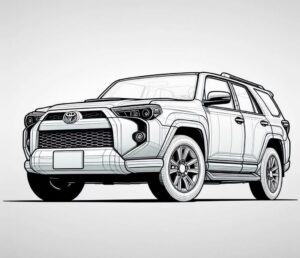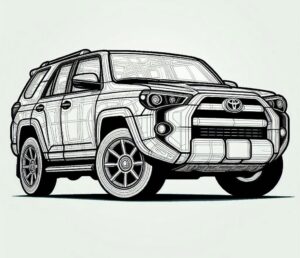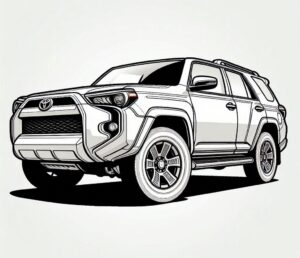The Toyota 4Runner is tough, reliable and ready for adventures or daily driving. Safe and reliable on every trip. With a repair manual you can fix problems, maintain and keep your 4Runner running for years.
A repair manual is an easy to use guide to fix and maintain your car. It helps to solve problems, change parts and do simple maintenance. Download it now and save money, build confidence and keep your Toyota 4Runner running for years to come.
Download Your Toyota 4Runner Workshop Manual 1995 – 2024
If you're not finding the right year for your exact car model or year, don't worry. We'll provide a service and repair manual tailored to your car.
Request A QuoteThe Toyota 4Runner Journey: Built to Last
The Toyota 4Runner was first released in 1984 and soon became known as a tough and reliable SUV. It was built to handle rough roads and city streets, perfect for families and adventure seekers. Millions of 4Runners have been sold worldwide.
Each 4Runner generation has brought new updates. Its model codes like N60 and N280 means big improvements in comfort and safety. Special editions like TRD Pro were made for off-road fun with features perfect for outdoor adventures.
The 4Runner has engines from 2.4L to 4.0L V6. This gives you the power to tow heavy loads and smooth ride. Today it has more than 270 horsepower, it’s strong and reliable.
As a mid size SUV the 4Runner has always had a front engine design with options for rear-wheel or all-wheel drive. It’s perfect for off-road adventures or running errands in the city. With over 4 million sold it’s a favorite among drivers everywhere.
First Generation (1984–1989) – N60
The Toyota 4Runner was first released in 1984 as a compact SUV built on the Hilux truck platform. This generation had a removable fiberglass top and a tough design perfect for off-roaders. Powered by a 2.4L 4-cylinder engine with 116 horsepower it later introduced a 3.0L V6 for more power. Rear-wheel drive with optional all-wheel drive made it good for city and trail driving.
Second Generation (1990–1995) – N120/N130
Released in 1990 the second generation had a fully enclosed body for better safety and comfort. It had more interior space and updated suspension for a smoother ride. Engine options were 2.4L inline-4 and 3.0L V6 with up to 150 horsepower.
Trim levels like SR5 added more luxury features. It’s all-wheel-drive capability and improved build made it a family friendly SUV.
Third Generation (1996–2002) – N180
The third generation had a major redesign with a more aerodynamic shape and more features. Launched in 1996 it had engines like 2.7L inline-4 and 3.4L V6 with up to 183 horsepower. Airbags was introduced as a safety feature. Its combination of off-road capability and urban refinement made it a mid-size SUV.
Fourth Generation (2003–2009) – N210
With a more aggressive and modern design the fourth generation was released in 2003. A 4.0L V6 was standard with 245 horsepower and a 4.7L V8 was added for more towing power.
This generation introduced advanced technology like stability control and navigation. Its spacious interior and engine options made it a favorite among families and adventure seekers.
Fifth Generation (2010–Present) – N280
The current generation was released in 2010 and focused on toughness and durability. Powered by a 4.0L V6 with 270 horsepower it balances off-road capability with modern features like touchscreen infotainment.
TRD Pro editions highlight its off-road capability and Toyota Safety Sense for safer driving. It’s still a popular SUV in the market.
Why Do You Need Toyota 4Runner OEM Manuals for Repairs?
Toyota 4Runner OEM Manuals is your ultimate solution to fix car problems fast and easy. Designed for owners and mechanics, it has detailed step-by-step instructions to make repairs hassle free. Accurate even for complex repairs.
Using Toyota 4Runner OEM Manuals will save you time and money by reducing mechanic visits. From oil change to engine problems, these guides have everything you need to maintain and repair your vehicle at home. It’s for every 4Runner model and trim.
These manuals are user-friendly with clear instructions, diagrams and troubleshooting tips. Beginners can do their first repair, experienced DIYers will love the detailed information. Troubleshooting electrical issues or performance maintenance has never been easier.
Not just for repairs, Toyota 4Runner OEM Manuals also has preventative care tips to ensure long term reliability. Learn how to follow a maintenance schedule, identify potential problems early and keep your car running for years to come. It’s an investment to your 4Runner.
- Comprehensive Diagrams: Visual aids for wiring, engine parts and systems for easier repair understanding.
- Troubleshooting Made Simple: Identify problems quickly with detailed problem solving guides.
- Maintenance Schedules: Avoid breakdowns by following factory recommended maintenance routine.
- Cost Effective Care: Save hundreds of repairs by doing it yourself.
- Model Specific: For each 4Runner year and trim.
- Safety First: Detailed safety tips to do complex repairs without risk.
- Advanced Features: Access to professional tools like diagnostic codes and part replacement steps.
Toyota 4Runner OEM Manuals is more than repair guides – it’s your partner for vehicle care. Whether you’re troubleshooting or doing maintenance, these manuals will give you the tools and knowledge to keep your 4Runner running for years. Start using them now and have worry-free ownership!
What’s Inside Toyota 4Runner Repair Manuals?
Toyota 4Runner Repair Manuals is for vehicle owners and mechanics. It has clear step-by-step instructions to help you maintain and repair your 4Runner with ease.
This covers basic maintenance like oil change to complex repairs like engine overhaul. By following the guide, you’ll keep your vehicle running smoothly and at its best.
Toyota 4Runner Manuals
- Repair Instructions: Step-by-step with illustrations to make complex repairs easy.
- Electrical Diagrams: Wiring diagrams to troubleshoot electrical systems and solve problems.
- Maintenance Schedules: Custom schedule for diesel and petrol engines to maximize vehicle performance.
- Diagnostic Tools: Error codes, troubleshooting steps and expert testing methods to find and fix problems.
Here’s what’s included:
- Engine tuning and adjustment
- Timing belt and chain
- Oil change and filter
- Cooling system
- Water pump
- Air filter
- Spark plug
- Battery
- Alternator
- Starter motor
- Transmission fluid
- Suspension
- Brake pad
- ABS sensor
- Fuel injector
- Exhaust
- Power steering
- Wheel alignment
- Tire rotation
- Air conditioning
- Cabin filter
- Electrical wiring
- ECU error code
- Headlight bulb
- Body panel
- Door lock and window mechanism
These manuals will give you the knowledge and confidence to keep your 4Runner running smoothly. Start using one today and have worry-free driving!
How to Get the Right Manual for Your Toyota 4Runner?
Getting the right manual for your Toyota 4Runner is crucial for repair and maintenance. Each model and year has different details and using the wrong manual will lead to mistakes or missed steps.
- Identify Your Model: Determine the specific model of your Toyota 4Runner. Whether it’s the SR5, TRD Off-Road, or Limited, knowing your model ensures the manual you choose includes relevant specifications and features.
- Confirm the Production Year: Check the exact production year of your 4Runner. Manuals are designed to reflect year-specific updates in technology, safety, and design. Using the right year guarantees accurate instructions for your vehicle.
- Use Your Vehicle Identification Number (VIN): Your 17-character VIN provides essential details, such as the 4Runner’s engine type and production details. Matching the manual with this information ensures precise and reliable guidance.
- Match the Engine Configuration: Toyota 4Runner models come with different engine options, such as the 4.0L V6. Selecting a manual that aligns with your engine ensures accurate maintenance and repair steps.
Using the wrong manual will lead to skipped steps, improper repair or damage. The right manual will give you accurate maintenance, correct torque settings and clear instructions for brake service, suspension adjustment, engine care.
Get Ready to Repair with Confidence
Toyota Camry manuals offer all the tools and knowledge you need. Grab your manual today, and start your DIY journey with confidence!
What Models and Trims Are Covered for Toyota 4Runner?
Your Toyota 4Runner deserves repair information specific to its model and trim. From the rugged SR5 to the premium Limited and off-road focused TRD models, each 4Runner trim has its own features and specifications that need precise maintenance guidance. Here are the Toyota 4Runner models and trims we cover:
Base and Premium Trims:
- SR5
- SR5 Premium
- Limited
- Limited Nightshade Edition
Off-Road Focused Models:
- TRD Sport
- TRD Off-Road
- TRD Off-Road Premium
- TRD Pro
Special Editions:
- 40th Anniversary Special Edition
- Trail Special Edition
Engine:
- 4.0L V6 Gasoline Engine (270 horsepower)
Drivetrain:
- Rear-Wheel Drive (RWD)
- Part-Time Four-Wheel Drive (4WD) with Active TRAC
- Full-Time Multi-Mode 4WD with TORSEN limited-slip center differential
Key Off-Road Features:
- Multi-Terrain Select
- Crawl Control
- Kinetic Dynamic Suspension System (KDSS)
- Locking Rear Differential
- FOX Shocks (TRD Pro)
These repair resources cover every Toyota 4Runner configuration, providing you with the exact information needed for proper maintenance and repairs of your specific model. Whether you own a city-driven Limited or a trail-ready TRD Pro, you’ll find detailed guidance for your 4Runner’s unique systems and features.
What’s The Best Way to Navigate Your Toyota 4Runner Manual?
Your Toyota 4Runner manual helps you take great care of your SUV. It’s like having a helper that knows everything about your car! Here’s how to use your manual in the easiest way possible:
- Access From Anywhere: Download the PDF with digital product version of your manual to your devices for easy reference anywhere. Having this digital guide on your phone or tablet means you’ll never be without important maintenance and repair information wherever your 4Runner takes you.
- Find Things Super Fast: Use the search box like you use Google. Want to know how to change a tire? Just type “tire change” and you’ll find it right away. No more flipping through pages like a boring textbook!
- Save Important Pages: Bookmark your favorite pages, just like using sticky notes in a book. Save things you check often, like when to change your oil or check your tires. This way you can jump to what you need.
- Look at the Pictures: The manual has lots of pictures that show you what to do. It’s like a comic book that teaches you about your car! Pictures make it much easier to understand how things work.
- Step by Step: Each job is broken down into simple steps, like a recipe. Whether you’re checking the oil or cleaning your car, the manual tells you exactly what to do, one step at a time.
- Find It Fast: The index in the back is like a treasure map – it helps you find what you’re looking for. Looking for info about your radio or air conditioning? The index will show you where to go.
- Fix It Easily: When something’s not right, the manual will help you troubleshoot. Hear a weird noise? Check the manual! It will show you what’s wrong and how to fix it.
- Your 4Runner Manual: Your 4Runner manual is like a mechanic in your pocket that helps you understand your car better. Whether you have a basic SR5 or a fancy TRD Pro, the manual makes taking care of your car easy.
What are the Common Issues in Toyota 4Runner and How Your Manual Can Help?
Your Toyota 4Runner is reliable but like any vehicle it can have some issues. Here are the common problems reported by owners and how your manual can help you diagnose and fix them:
- Dashboard Warning Lights: When VSC and TRAC lights come on together. Your manual explains each warning light and gives you a step by step troubleshooting guide.
- Front Lower Ball Joint Wear: Especially in older models, causes clunking noise when turning. Your manual has inspection procedures and maintenance intervals to prevent premature wear.
- Automatic Transmission Shifting Problems: Some owners reported delayed or rough shifting especially in 2003-2005 models. Your manual has transmission diagnostic procedures and fluid maintenance schedule to prevent these issues.
- Rear Differential Issues: Whining noise or vibration can mean rear differential problems. Your manual has fluid types, maintenance intervals and diagnostic steps for differential care.
- Air Injection Pump Failure: Common in 2003-2009 models, triggers check engine light. Your manual has diagnostic trouble codes and testing procedures to identify pump related issues.
- Frame Rust: Older models (especially 2003-2009) may have frame rust. Your manual has inspection points and preventive maintenance recommendations for frame protection.
- Suspension System Noises: Especially in models with KDSS (Kinetic Dynamic Suspension System). Your manual has diagrams and troubleshooting steps for various suspension components.
- Air Conditioning Performance: Some units have AC system issues especially in older models. Your manual has AC system diagnostic procedures and maintenance schedule to keep your AC cool.
- Exhaust Manifold Leaks: Causes ticking sound and decreased performance. Your manual has inspection procedures and torque specs for manifold hardware.
- Brake System Problems: Some owners reported premature brake wear or squeak. Your manual has comprehensive brake inspection procedures and maintenance intervals for optimal brake performance.
Each of these issues has its own diagnostic procedure and solution in your manual. Following the manual’s maintenance schedule can prevent many of these problems from happening.
Why Do DIY Repairs and Mechanics Love Manuals?
Having a Toyota 4Runner repair manual is like having a personal mechanic at your disposal. With step by step instructions and pictures, it makes complex repairs easy. Instead of spending hours at the shop or paying big bills, you can take control of your car and gain valuable skills.
A repair manual is more than a guide – it’s a tool to manage your car. From tracking maintenance schedules to finding the exact parts your 4Runner needs, it eliminates guesswork and ensures every task is done right.
Follow its instructions and you’ll save money, avoid breakdowns and have peace of mind knowing your car is always road ready.
What You’ll Get
- Save on Repairs: Do oil changes and brake adjustment at home and cut down on mechanic bills.
- Solve with Precision: Troubleshoot and fix electrical problems or engine noise with step by step instructions.
- Gain Confidence: Do advanced repairs like suspension tweak or timing belt replacement with instructions specific to your Camry.
- Be Safer: Follow safety protocols and diagrams to do repairs without risk.
- Performance: Follow maintenance schedules like filter replacement and fluid check to keep your car running smooth.
- Emergency Fix: Be prepared for roadside situations like jump starting a dead battery or overheating engine with ease.
- Learn New Skills: Gain DIY repair knowledge and skills, become more self sufficient and informed about your vehicle.
- Upgrade Your Vehicle: Use the manual to install upgrades like modern infotainment system, LED lighting or safety features.
- Find Parts Fast: Use part numbers and specs to buy the right parts every time.
- Stay on Track: Use the manual to track maintenance schedule and keep your car care in check.
- Eco-Friendly Maintenance: Learn how to dispose of old fluids and parts properly, reduce environmental impact.
What Tools Do I Need for Toyota 4Runner DIY Repairs?
Taking care of your Toyota 4Runner yourself is a great way to save money and be in control of your car’s maintenance. Doing your own repairs doesn’t just save on shop bills – it also gains confidence and knowledge of your SUV.
To do DIY repairs successfully, you need the right tools at hand so every job is safe, smooth and efficient.
Here’s a simple and practical list of the must have tools for your Toyota 4Runner repairs:
Basic Tools
- Metric Socket Set (10mm to 22mm)
- Hydraulic Floor Jack and Stands
- Metric Wrench Set
- Torque Wrench
- Oil Filter Wrench
Engine Tools
- Compression Tester
- Spark Plug Socket
- Timing Chain Tool Kit
- Injector Puller
- Valve Lash Adjustment Tools
Suspension and Brake Tools
- Ball Joint Press
- Coil Spring Compressor
- Brake Bleeder Kit
- Wheel Hub Puller
- Axle Nut Socket
Diagnostic Tools
- OBD2 Scanner
- Multimeter
- Battery Load Tester
- Vacuum Gauge
- Fuel Injection Pressure Tester
Safety Equipment
- Safety Goggles
- Heavy-Duty Gloves
- LED Underhood Light
- Wheel Chocks
- Fire Extinguisher
Specialized Tools
- Fan Clutch Wrench
- Coolant System Tester
- Transfer Case Removal Tool
- Steering Rack Tools
- CV Joint Boot Clamp Tool
Fluid Management Tools
- Oil Drain Pan
- Large Funnel Set
- Fluid Transfer Pump
- Brake Bleeder Bottle
- Grease Gun with Flexible Hose
With these tools in your garage, you’re ready for anything your 4Runner throws at you. Whether it’s maintenance or repairs, you’ll be efficient and safe.
Why Toyota 4Runner Owners Love OEM Service Manual?
Owning a 4Runner is about adventure and reliability. The OEM Service Manual is your best friend when it comes to keeping your SUV in top shape whether you’re on the road or off the road. Written specifically for your vehicle this manual gives you the confidence and ability to do repairs, maintenance and troubleshooting with ease. Here’s why every 4Runner owner loves this must have tool:
1. Made Just for Your 4Runner
The OEM Service Manual isn’t a one size fits all guide—it’s made for your specific 4Runner model, year and trim. Whether you’re inspecting your suspension system or replacing timing belts it has exact, step by step instructions for your vehicle. No more guesswork, just model specific information you can trust.
2. Repairs Made Simple, Even for Novices
The manual breaks down complex repairs into easy to follow, step by step instructions. From oil changes to transmission overhauls it makes every job simple. No technical background? No problem. The OEM Service Manual ensures even first time DIYers can get the job done right.
3. Clear Diagrams and Pictures
Ever get frustrated with vague instructions? The manual eliminates that with detailed diagrams and illustrations. See exactly how parts fit together, see your brake system layout and identify wiring connections with pictures that make every repair simple and stress free.
4. Troubleshooting Made Easy
When warning lights come on you don’t have to freak out. The OEM Service Manual has detailed troubleshooting guides for common problems like engine misfires, fuel system issues and electrical problems. Decode error codes with ease and find the fix without wasting time and money on unnecessary repairs.
5. Save on Repairs and Maintenance
Tired of big mechanic bills? The OEM Service Manual puts you in control. Do routine tasks like replace spark plugs, change filters and flush fluids at home. With this manual you’ll save hundreds or even thousands on labor costs and keep your 4Runner running smooth.
6. Build Your Skills, One Fix at a Time
Every repair is an opportunity to build your skills and confidence. The manual doesn’t just teach you how to fix your 4Runner it turns you into a capable and knowledgeable DIYer. Whether you’re tightening a loose belt or solving a coolant leak you’ll feel like a pro every step of the way.
7. Safety First Always
Repairs should never put you or your vehicle in danger. The OEM Service Manual has expert safety tips for tasks like brake adjustments, battery checks and tire rotations. With this manual you’ll do every repair safely and avoid risks to yourself and your 4Runner.
Case Studies
-
Liam used the OEM Service Manual to fix a suspension issue on his Toyota 4Runner. With step by step instructions he replaced worn out shock absorbers and saved almost €600 in repair costs. “I never thought I could do such a big repair but the manual made it so simple” Liam says happy with the result.
-
Fatima had flickering headlights and an erratic power window on her 4Runner. Using the troubleshooting section of the OEM Service Manual she found the problem was a faulty fuse and a loose wiring connection. “The diagrams and instructions were a lifesaver,” Fatima says, adding that the manual gave her the confidence to do future electrical repairs.
-
Daniel used the OEM Service Manual to manage his 4Runner’s maintenance. He did oil changes, air filter replacement and tire pressure checks himself. “The manual helped me create a maintenance routine that saves me money and keeps my SUV running smoothly,” Daniel says.
-
Mei used the OEM Service Manual to fix an overheating problem on her 4Runner. By following the cooling system troubleshooting guide she found and replaced a faulty radiator. “I avoided a trip to the repair shop and now my car runs perfectly,” Mei says, calling the manual a must have for every car owner.
Start using an OEM Service Manual today
Whether it’s for simple tasks or big repairs, it’s the tool every Toyota owner needs to get the job done right.
frequently Asked Questions
















